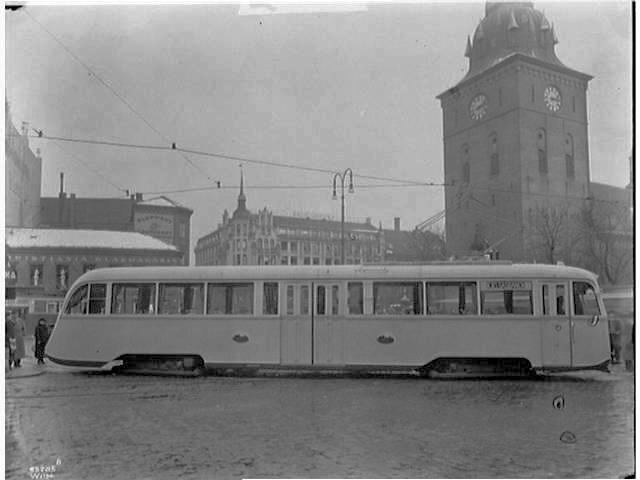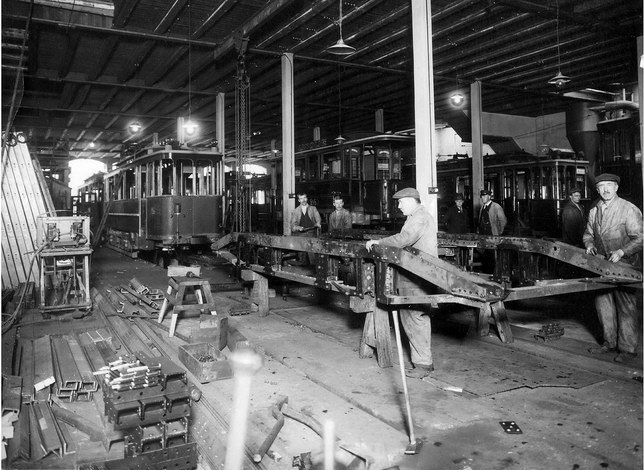|
Gullfisk Tram
Class B and Class E, normally referred to as ''Gullfisk'' ( Norwegian for "goldfish"), were a class of 46 trams built by Strømmens Værksted and Skabo Jernbanevognfabrikk for Oslo Sporveier and Bærumsbanen of Oslo, Norway, in 1937 and 1939. They were the first aluminium trams to operate on the Oslo Tramway and the first bogie trams to operate on street lines. They had contemporary modern electronic equipment, a streamlined shape, and comfortable accommodation. Until 1964, they were also faster than any other Norwegian tramcar or suburban railcar. Six prototype trams were delivered by Strømmen in 1937, with four different motor solutions, from AEG, Siemens, Vickers and Norsk Elektrisk & Brown Boveri (NEBB). None of these were particularly successful, and the 40 serial production trams used conventional motors from ELIN. These were delivered in 1939, with 20 (class E) being used by Oslo Sporveier mainly on the Kjelsås Line, but also on other services. The remaining 20 trams (cla ... [...More Info...] [...Related Items...] OR: [Wikipedia] [Google] [Baidu] |
Siemens Mobility
Siemens Mobility GmbH is a division of Siemens. With its global headquarters in Munich, Siemens Mobility has four core business units: Mobility Management, dedicated to rail technology and intelligent traffic systems, Railway Electrification, Rolling Stock, and Customer Services. History Innovations from the late 19th century, such as the world's first electric train, when Siemens & Halske unveiled a train in which power was supplied through the rails, and the world's first electric tram, with the implementation of 2.5-kilometer-long electric tramway located in Berlin, built at the company's own expense, cemented the use of electric power in transportation systems. In the following years, inventions such as the first electric trolleybus, mine locomotives, and the first underground railway in continental Europe (in Budapest), set the path from trams and subways to today's high-speed trains. Siemens, alongside ThyssenKrupp and Transrapid International, was part of the Germa ... [...More Info...] [...Related Items...] OR: [Wikipedia] [Google] [Baidu] |
Horsecar
A horsecar, horse-drawn tram, horse-drawn streetcar (U.S.), or horse-drawn railway (historical), is a tram or streetcar pulled by a horse. Summary The horse-drawn tram (horsecar) was an early form of public transport, public rail transport, which developed out of wagonway, industrial haulage routes that had long been in existence, and from the Omnibus (Horse-drawn vehicle), horse-drawn omnibus routes that first ran on public streets in the 1820s, using the newly improved iron or steel rail or 'Tramway (industrial), tramway'. They were local versions of the stagecoach lines and picked up and dropped off passengers on a regular route, without the need to be pre-hired. Horsecars on tramlines were an improvement over the omnibus, because the low rolling resistance of metal wheels on iron or steel track (rail transport), rails (usually Rail profile#Grooved rail, grooved Tram#History, from 1852 on) allowed the horses to haul a greater load for a given effort than the omnibus, and ga ... [...More Info...] [...Related Items...] OR: [Wikipedia] [Google] [Baidu] |
Kristiania Sporveisanlæg
Homansbyen Depot (), officially Kristiania Sporveisanlæg ("Kristiania Tramway Installation") was an Oslo Tramway motive power depot, depot located at Sporveisgata 8 near Bislett in Oslo, Norway. It was constructed for Kristiania Sporveisselskab in 1874 and was the first tramway depot in the country. The facilities were designed by Henrik Thrap-Meyer and featured an administrative office, a horse stable, a forge, a workshop, a weighing shed, and a wagon depot. It had space for 28 horse wagons, 16 sleds, and 116 horses. The administrative office was built in brick and housed apartments, offices, and a laboratory for the veterinarian. The depot was reconstructed several times, and taken out of use in 1966. It was demolished three years later, and replaced with residential apartment blocks. History The tramway operating company Kristiania Sporveisselskab was established on October 2, 1874, and started scheduled horse tram services on October 6, 1875. The network comprised a line f ... [...More Info...] [...Related Items...] OR: [Wikipedia] [Google] [Baidu] |
Gullfisk Stortorvet
Class B and Class E, normally referred to as ''Gullfisk'' (Norwegian language, Norwegian for "goldfish"), were a class of 46 trams built by Strømmens Værksted and Skabo Jernbanevognfabrikk for Oslo Sporveier and Bærumsbanen of Oslo, Norway, in 1937 and 1939. They were the first aluminium trams to operate on the Oslo Tramway and the first bogie trams to operate on street lines. They had contemporary modern electronic equipment, a streamliner, streamlined shape, and comfortable accommodation. Until 1964, they were also faster than any other Norwegian tramcar or suburban railcar. Six prototype trams were delivered by Strømmen in 1937, with four different motor solutions, from AEG (German company), AEG, Siemens Mobility, Siemens, Vickers and Norsk Elektrisk & Brown Boveri (NEBB). None of these were particularly successful, and the 40 serial production trams used conventional motors from ELIN. These were delivered in 1939, with 20 (class E) being used by Oslo Sporveier mainly on th ... [...More Info...] [...Related Items...] OR: [Wikipedia] [Google] [Baidu] |
Loading Gauge
A loading gauge is a diagram or physical structure that defines the maximum height and width dimensions in railway vehicles and their loads. Their purpose is to ensure that rail vehicles can pass safely through tunnels and under bridges, and keep clear of platforms, trackside buildings and structures. Classification systems vary between different countries, and loading gauges may vary across a network, even if the track gauge is uniform. The term loading gauge can also be applied to the maximum size of road vehicles in relation to tunnels, overpasses and bridges, and doors into automobile repair shops, bus garages, filling stations, residential garages, multi-storey car parks and warehouses. A related but separate gauge is the structure gauge, which sets limits to the extent that bridges, tunnels and other infrastructure can encroach on rail vehicles. The difference between these two gauges is called the clearance. The specified amount of clearance makes allowance for ... [...More Info...] [...Related Items...] OR: [Wikipedia] [Google] [Baidu] |
Oslo Tramway Museum
Oslo Tramway Museum ( is a railway museum located at Majorstuen in Oslo, Norway. It is dedicated to the preservation of the Oslo Tramway, Oslo T-bane, Oslo trolleybus and buses used in Oslo. The museum is run by the non-profit organization Lokaltrafikkhistorisk Forening with 645 members (2019). The museum also operates a heritage tramway in Vinterbro outside Oslo. Lokaltrafikkhistorisk Forening was founded in 1966, six years after the city council had decided to close down the tramway and trolleybus. This followed the closing of the Bergen Tramway, where only a single tram had been kept. As of 2004, the museum had 56 rail vehicles, 31 buses and seven other vehicles. This included four trolleybuses. Majorstuen The tramway museum at Majorstuen is located in Depot 5. Since 1985, the museum has been connected to the tramway at Majorstuen Station. This consists of a hall with 25 trams, 10 buses and other vehicles on display, as well as offices for the organization and a store. Th ... [...More Info...] [...Related Items...] OR: [Wikipedia] [Google] [Baidu] |
Strømsveien Tram Fire
The Strømsveien tram fire (''Trikkebrannen i Strømsveien'') was a railway accident resulting from a fire erupting in an Oslo Tramway car traveling on Strømsveien street in Oslo, Norway. On 2 August 1958, a set of two cars, 194 and 198, of the Gullfisk tram, Gullfisk type was traveling the Lilleaker Line ('' Lilleakerbanenen'') – Østensjø Line (''Østensjøbanen'') route from Bøler to Jar (station), Jar. This connection was opened in 1937 and the Gullfisk cars introduced in 1939. As the tram braked as it approached Totengata a technical malfunction caused arcing and a fire erupted in the front of car 198 which was the latter car. The exit door, being operated by the tram driver who was seated in the lead car, remained closed for a few, critical seconds as passengers were struck by panic. The disaster claimed the lives of five people; seventeen were injured. Following the disaster, fire extinguishers, better emergency exits and emergency door openers became mandatory in ... [...More Info...] [...Related Items...] OR: [Wikipedia] [Google] [Baidu] |
Ekeberg Line
The Ekeberg Line () is a long light rail line of the Oslo Tramway which runs from Oslo Hospital to Ljabru in Oslo, Norway. Operated by lines 13 and 19, it serves the area of Nordstrand and the neighborhoods of Ekeberg, Jomfrubråten, Bekkelaget and Ljan. The line is operated by Oslo Sporvognsdrift using SL79 and SL95 trams on contract with Ruter. The line itself is owned by Sporveien. At Oslo Hospital, the line connects to the Bjørvika Line, which runs to the city center. Proposals for a line in the area were first launched 1897, but not until 1914 were the necessary permits granted. The line was built and operated by Ekebergbanen. The line opened in 1917, and connected to the Gamleby Line to reach Stortorvet in the city center. The line differed from the street trams in that it ran in its own right of way and used 1,200 volt supply, unlike the 600 volts used in the streets. In the early 1930s, the line was rebuilt to double track and a branch, the Simensbråten L ... [...More Info...] [...Related Items...] OR: [Wikipedia] [Google] [Baidu] |
Østensjø Line
The Østensjø Line () is a line on the Oslo Metro which runs from Brynseng (station), Brynseng to Mortensrud (station), Mortensrud. It further shares track with the Lambertseter Line along the section from Tøyen (station), Tøyen to Brynseng. The line runs through the primary residential areas of Bøler, Østensjø and Søndre Nordstrand. The line is served by Line 3 of the metro. The first section of the line was built by Akersbanerne as part of the Oslo Tramway and connected to the Vålerenga Line at Etterstad. The first section, to Bryn, opened on 18 December 1923, and was extended to Oppsal (station), Oppsal in January 1926. Services were variously provided by Kristiania Sporveisselskab, Bærumsbanen and Oslo Sporveier. Proposals for making the line part of the metro arose in the late 1940s and the system was approved in 1956. This materialised in an extension of the line to Bøler (station), Bøler on 20 July 1958. The Østensjø Line became the third line of the metro on ... [...More Info...] [...Related Items...] OR: [Wikipedia] [Google] [Baidu] |
Kolsås Line
The Kolsås Line () is a line of the Oslo Metro. It branches off from the Røa Line at Smestad (station), Smestad Station and runs through western Oslo and Bærum to Kolsås (station), Kolsås Station. It serves the neighborhoods of Ullernåsen, Øraker, Jar, Norway, Jar, Bekkestua, Haslum, Gjettum and Kolsås. It is served by Line 3 of the metro at a 15-minute headway. The section from Jar (station), Jar to Bekkestua (station), Bekkestua is built as a dual system with overhead wires, allowing Line 13 of the Oslo Tramway to continue from the Lilleaker Line to Bekkestua every ten minutes. The Kolsås Line was built as an extension of the Lilleaker Line. It had been built to Lilleaker (station), Lilleaker in 1919. The line was extended to Avløs (station), Avløs on 1 July 1924, and the line was extended to Kolsås on 1 January 1930. The line was initially owned by Bærumsbanen, which was bought by Oslo Sporveier in 1934. A connection to the Røa Line opened on 15 June 1942, allowi ... [...More Info...] [...Related Items...] OR: [Wikipedia] [Google] [Baidu] |







